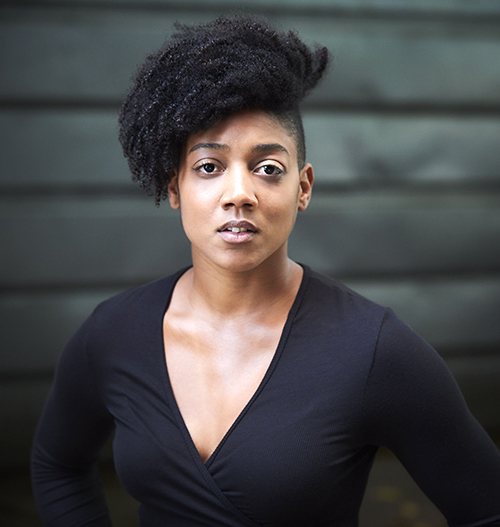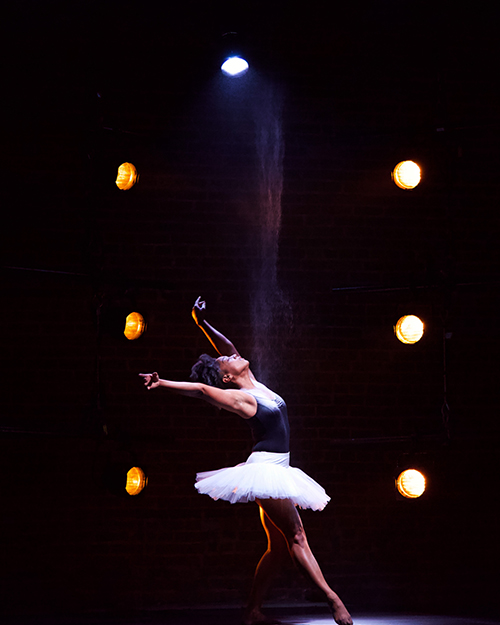Syreeta Hector (MA ’16) is a highly accomplished dance artist and educator who has worked for several internationally recognized companies. Her work, Black Ballerina, has garnered much attention and praise since its debut and has been nominated for a Dora Mavor Moore Award and won the Stratford Festival Lab Award for Research and Creation in 2019.

Why did you decide to pursue your Master of Arts in Dance from York?
When I was working with the Toronto Dance Theatre, we did a residency at York where we worked with the students. I remember the chair of the department said, “You all are welcome to come do more studies here. You are so welcome to join this dance community and to join the York community. Just talk to me after.” And I was like, “I think I want to be here. I think this is a really lovely place.” So that was my first introduction to York University. The fact that the chair was really making efforts to bring the dance community from downtown to York to build community and relationships was very unique. They welcomed me with open arms, and I’ve never forgotten that.
What drew you to dance? Do you come from a family of artists?
When I was little, four our five, I did dance for a year and quit. I didn’t feel like it was a place for me. There was a dance-a-thon that was supposed to be fun, and I remember there was a little girl that said “Why do you look like that? Your skin.”
It was in high school that I started seriously dancing. I went to school in North Carolina and dance was an elective in grade 9. I had a Black dance teacher named Miss Allen, not thee Miss Allen, and she said, “I think there’s something here for you. Don’t worry about the money – come take classes and see if you like it.” And I am forever thankful for her because I was from a single parent family and Miss Allen basically took a bunch of us in and said, “Here are the opportunities and if you want to pursue this seriously, we can give you options.” And it’s one of those things – once I started, I just couldn’t stop. I was enthralled by the athleticism and the grace that comes with dancing.
Can you talk about Black Ballerina – how long it took to create and how it came to be?
Black Ballerina is based on my personal experience. I think about when I started practicing ballet and all the different boundaries that are in place because of systemic racism. This idea of identity and Eurocentric based dance forms – who we see on stage and who is left behind.
Black Ballerina in a logistical sense started when I was doing my Masters as part of my major research paper. I was able to look at my family history and relate it to what I do right now and the type of dance forms that I practice. From there, I applied for Canada Council funding in 2018 to take what I’d learned from paper into performance. I received creation grants to start Black Ballerina and as I was performing these short segments around themes of identity and my relationship to my own Blackness and Indigeneity there was real hunger from other people. They’d say, “What you did is how I feel every day,” and I thought “Okay so it’s not just me.”

So, I had all these seeds for creation, and thought, “What would happen if I removed the limitations of what I think I should do? What if I don’t apologize and make the piece that I want to make?” And that was really how Black Ballerina came about.
How would you describe your work?
Part of my choreography comes from academic research and what I find. What are the commonalities and what are the differences within our histories? And then from a physical side, I always love elements of athleticism and these attempts to strive to convey things. I hope my work is accessible. I hope that people are curious when they watch it, and they see part of themselves within the work…or they know someone it reminds them of. That’s how I create. I start with the people in the room – the bodies in the room – and what our dance histories and blood memories say.
You are Mi’kmaq, African Canadian, and French Acadian – how do those parts of you make its way into your dance?
For a long time, I didn’t know about my indigenous heritage. That history was completely not talked about in hopes of being forgotten due to colonialism…and also due to my family not wanting to talk about it. But I want to know. So, one of the underlying themes within my work is bringing forth these complicated histories. There is a very complicated history of African and Indigenous people in Nova Scotia – why didn’t I learn about it in school? Why was it during my Masters that I was able to start learning about this crazy, important history? That always comes back to how I feel about dancing and how I feel about being in the world. I don’t want to forget anything. I don’t want to forget my ancestors.
What does Black History month mean to you?
When I think about Black History month now, I think it shouldn’t just be the month. It’s like when everyone put the [black] squares up [on social media in 2020]. It’s like, “Great. We all put the square up and then it’s over.” For me Black History Month is not just a month. It’s an ongoing curiosity and conversation. It means that with the position I’m in that I can highlight things in a different way – through art and through dance. I feel full of privilege to do that because my ancestors were taught to forget who they were. And I think that’s extremely important to acknowledge in Black History Month. A lot of our ancestors were taught to forget who they were in order to survive. So that’s what Black History Month means to me right now.
Are you working on any new work – what’s next?
I have been commissioned to make new works for two different dance companies. My piece with Mocean Dance in Halifax will premiere in April and my work with ProArteDanza in Toronto will premiere in the fall. And then Black Ballerina is going on tour – there will be Atlantic Canada dates for 2023 and in 2024 I’ll be going to Europe.
Do you have any advice for students – particularly those who want to pursue a career in arts?
I would say, start before you’re ready.
